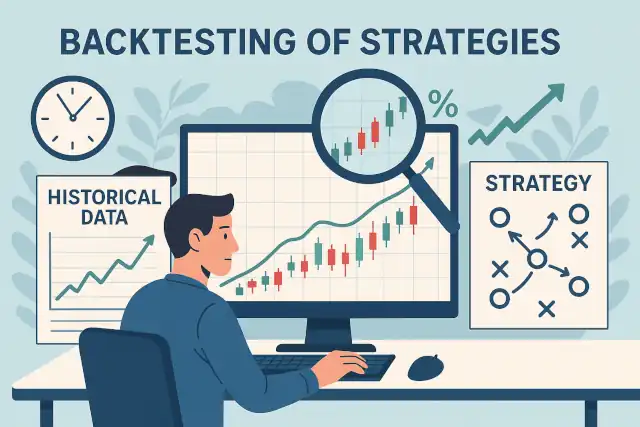How to Do Proper Backtesting: A Step-by-Step Guide for Traders
AndyVentura • 5/10/2025, 3:17:18 PM

How to Do Proper Backtesting: A Step-by-Step Guide for Traders
Backtesting is an essential process in algorithmic trading that allows traders to evaluate the effectiveness of a trading strategy using historical data. Proper backtesting helps you understand how your strategy would have performed in the past, giving insights into its potential future performance. However, conducting backtesting correctly requires attention to detail, understanding of market data, and awareness of common pitfalls.
In this article, we will walk you through how to do proper backtesting, covering everything from data selection to interpreting results.
What Is Backtesting?
Backtesting involves applying a trading strategy or algorithm to historical market data to simulate its performance. By doing this, traders can estimate the strategy’s profitability, risk, drawdowns, and other performance metrics before risking real capital.
Why Is Proper Backtesting Important?
Without proper backtesting, a trading strategy might look promising but fail in live markets. Common mistakes like look-ahead bias, survivorship bias, or overfitting can give misleading results. Proper backtesting helps avoid these issues and ensures your strategy is robust and reliable.
Step 1: Gather Clean and Relevant Historical Data
The foundation of any backtest is quality data. Here are key points to consider:
- Data Type: Use the type of data your strategy requires (e.g., tick, minute, daily).
- Data Quality: Ensure data is clean, free from errors, and adjusted for corporate actions like splits and dividends.
- Data Completeness: Avoid gaps in data that can distort results.
- Survivorship Bias: Use data sets that include delisted securities to prevent bias.
Step 2: Define Your Trading Strategy Clearly
Before backtesting, formalize your trading rules explicitly. This includes:
- Entry conditions
- Exit conditions
- Position sizing rules
- Risk management parameters
A strategy must be unambiguous so that it can be coded and tested without subjective interpretation.
Step 3: Choose the Right Backtesting Platform or Tool
Select a backtesting environment that supports your strategy requirements and data format. Popular platforms include:
- Python libraries (e.g., Backtrader, Zipline)
- Commercial platforms (e.g., TradeStation, MetaTrader)
- Dedicated algorithmic trading platforms
Ensure your platform can handle realistic order execution, slippage, and commissions.
Step 4: Incorporate Realistic Trading Assumptions
Your backtest should mimic real-world trading conditions as closely as possible:
- Slippage: Account for price changes between signal generation and order execution.
- Commissions and Fees: Deduct realistic transaction costs.
- Liquidity Constraints: Ensure the market can absorb your trade size.
- Order Types: Model market, limit, and stop orders accurately.
Step 5: Avoid Common Backtesting Pitfalls
- Look-Ahead Bias: Do not use future data when making trading decisions.
- Overfitting: Avoid tailoring your strategy too closely to historical data.
- Survivorship Bias: Include all instruments, not just current ones.
- Data Snooping: Resist testing too many strategies on the same data set.
Step 6: Run the Backtest and Analyze Results
After implementing your strategy, run the backtest and evaluate performance metrics such as:
- Total Return: Overall profit or loss.
- Annualized Return: Average yearly return.
- Volatility: Measure of return fluctuations.
- Sharpe Ratio: Risk-adjusted performance.
- Maximum Drawdown: Largest peak-to-trough loss.
- Win Rate: Percentage of profitable trades.
Visualize equity curves, drawdowns, and trade distributions to understand behavior.
Step 7: Conduct Robustness Checks
Test your strategy under different conditions to verify stability:
- Out-of-Sample Testing: Test on data not used during strategy development.
- Walk-Forward Analysis: Continuously update and test the model.
- Parameter Sensitivity: Check how changes in parameters affect results.
- Monte Carlo Simulations: Evaluate performance with randomized sequences.
Step 8: Document and Iterate
Keep detailed records of your backtesting process, assumptions, and results. Use insights to refine your strategy and repeat testing to improve robustness.
Summary
Proper backtesting is a critical step in developing algorithmic trading strategies. It requires:
- High-quality, unbiased historical data
- Clearly defined and codified trading rules
- Realistic assumptions about trading costs and execution
- Awareness and avoidance of common biases
- Comprehensive performance analysis
- Robustness testing
By following these steps, you increase the likelihood that your strategy will perform well in live markets, helping you trade with confidence.
Additional Resources
Start your backtesting journey today to unlock the full potential of your trading strategies!